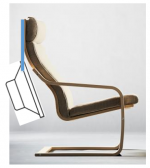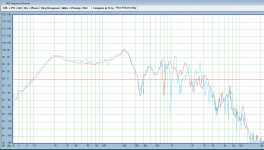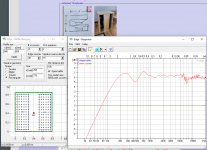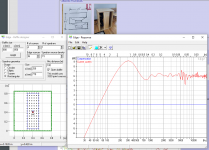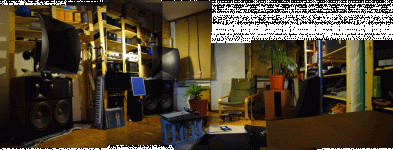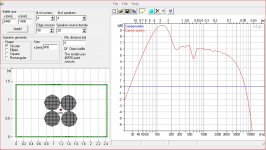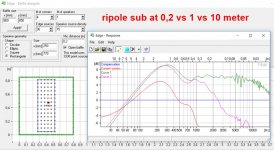IIRC I used 100Hz linear phase 1st order Neville-Thiele as provided by the Acourate Toolbox for DSP XOver and room correction package. I actually happened to have an IKEA Poang and the 18" 30cm behind the stool was located at chest-height firing 20° or so upwards as simply established by suspending the driver from two adjacent mounting holes with ropes. From that angle our sensitivity to noise etc is lowest, it seems.
In spite of this, say rather crude, quick&dirty setup I found the result was stunning. Headphone-like bass... but that was a weak point long-term, for most of the music I listen to I prefer the "monopole slam" in the low bass. Plus form-factor and aesthetic reasons made me gave up this route.
something like this?
Attachments
No, that would be too close and too low. The speaker was hung from a seperate stand, a heavy mic stand. The armrests for the Poang could be extended to behind the stool and connected with a cross-bar from where the driver hangs down, if you want to go for an "integrated solution" ;-) Might need an added front weight so the Poang doesn't fall over when not occupied...
Last edited:
For sweet-spot-only duty in a small room a near-field OB mono-bass (15"...21" nude is nice for this) mounted behind the seat is also an option and if you couple it to the chair mechanically it doubles up as a shaker (but then maybe better float the chair on dampers). Should give serious impression of very deep bass even down below 20Hz.
Yes.
As you get closer to the source low freq.s elevate in pressure relative to the average AND you get a substantial reduction in non-linear effects AND you get more tactile sensation (..even if you don't physically couple the driver's frame to your chair's frame and "float" the chair).
Plus of course you don't need as much spl, with lower overall "noise" (modal-booming/droning) means it's a bit less of a problem with regard to near-rooms and neighbors.
As long as you aren't looking for the absolute in lower freq. soundstage, a well-setup nearfield low-freq. monopole is close to perfection (for a single listener).
If you want the best in soundstage there are two solutions, one of which is the nearfield stereo dipole with enough cancellation in pressure for a head-shading effect.
Last edited:
Why too close?No, that would be too close and too low.
Yes.
As you get closer to the source low freq.s elevate in pressure relative to the average AND you get a substantial reduction in non-linear effects AND you get more tactile sensation (..even if you don't physically couple the driver's frame to your chair's frame and "float" the chair).
Plus of course you don't need as much spl, with lower overall "noise" (modal-booming/droning) means it's a bit less of a problem with regard to near-rooms and neighbors.
Absolutely, and it will give you some of the best quality bass you will ever hear indoors. Interestingly a dipoles response flattens out as you get closer to the source. Many dipole bass speakers will need no eq to flatten the bottom end.
As long as you aren't looking for the absolute in lower freq. soundstage, a well-setup nearfield low-freq. monopole is close to perfection (for a single listener).
A second or third listener is easy to accommodate, just add a second or third nearfield sub.
If you want the best in soundstage there are two solutions, one of which is the nearfield stereo dipole with enough cancellation in pressure for a head-shading effect.
"Low frequency sound stage" does not exist in small rooms and I doubt it even exists in big ones. Ever tried switching stereo subs crossed at 80Hz or below to mono? I can't detect a difference.
"Low frequency sound stage" does not exist in small rooms and I doubt it even exists in big ones. Ever tried switching stereo subs crossed at 80Hz or below to mono? I can't detect a difference.
Oh, but it does.
I gave one means of producing it, and its NOT just about mitigating room effects. (..and I also gave the reason why.)
I always figured it was an ice cream cone that would "freeze" the curve.Then I click the icon that looks like a blue mop head (I have no idea what it is supposed to be)
Of course in nearfield there won't be any dipole cancellation, you will hear (or measure) better response. And of course there won't be reflections or modes etc. because the direct sound is masking them.
But these aspects are not relevant when Charlie wants to make just a stereo pair of multiway dipole speakers. Building a home theater room would give opportunity to IB subwoofers and 7-15 in-wall speakrs, shakers etc. fancy cadgets. This system is in my home town, but I don't know the guy.
I have been considering dipole woofer units for many years naturally, at least to find out the difference to monopole unit. I would need a pair of them to find out how stereo works in my room with them. Now I anxiously wait to hear impressions from Charlie!
But these aspects are not relevant when Charlie wants to make just a stereo pair of multiway dipole speakers. Building a home theater room would give opportunity to IB subwoofers and 7-15 in-wall speakrs, shakers etc. fancy cadgets. This system is in my home town, but I don't know the guy.
I have been considering dipole woofer units for many years naturally, at least to find out the difference to monopole unit. I would need a pair of them to find out how stereo works in my room with them. Now I anxiously wait to hear impressions from Charlie!
Of course in nearfield there won't be any dipole cancellation, you will hear (or measure) better response. And of course there won't be reflections or modes etc. because the direct sound is masking them.
..I have been considering dipole woofer units for many years naturally, at least to find out the difference to monopole unit. I would need a pair of them to find out how stereo works in my room with them..
I've mentioned the "trick" to this before.
Near-field:
1. Stereo dipole,
2. adjust the driver so that the null drops-off significant (3db or more) pressure between one ear and the other. In otherwords get it to where there is cancellation for the listener. (..note that this isn't simply a matter of driver direction because of phase rotation/delay.) Ideally you do it with good measurements, but you can still hear it when it's operating properly.
-again, it's that pressure difference (ILD) at lower freq.s that is utterly uncommon (regardless of room effects). Not unlike head-shading at higher freq.s that naturally produce ILD.
Try it with a range of material. A fair bit just isn't mixed with much difference between L & R.. but when it is - it's quite noticeable. (..no doubt that those using headphones in the production process typically produce material that has more L & R lower freq. differences.)
(..of course when the pressure difference is too great you'll get an in-head effect like what headphones produce (..regardless of the material), but here (near-field dipole setup with cancellation) we aren't talking about much of a pressure difference between the listener's ears and certainly no where near the difference with headphones - even when using open-back headphones.)
Last edited:
I would first like to observe that this thread seems to have a lot of speculation and novel theories and very little evidence by way of measurements.
Second, I think some people's subjective judgments of bass goodness are wrong, mistaking pop recordings with lots of boost 60-90 Hz for the real low bass thing. Again, measurements are needed (including real-time analysis of just what bass is on the recordings cited).
Sticking a dipole sub behind your head follows the same principles as sticking any other kind of sub behind your head. And it doesn't change the acoustics of the dipole from a dipole in other locations. For example, it doesn't change the cancellation analysis except that in the absence of reflections, you are missing the phase randomization advantages that you get near a wall. For sure, you do get extreme time-misalignment with the satellites.
But an important advantage of an up-close dipole sub is that you can pump in real big Linkwitz Transform and not over-drive the driver.
Many decades ago, I took a spare 12-inch full-range driver ("Norelco") and hung it naked on a cord from my workshop ceiling near my head. It was wired in series with a large-value toroid coil I found in the Bell Labs stockroom, simple as that. Pretty nice sound, at least while the tools were running in the background.
B.
Second, I think some people's subjective judgments of bass goodness are wrong, mistaking pop recordings with lots of boost 60-90 Hz for the real low bass thing. Again, measurements are needed (including real-time analysis of just what bass is on the recordings cited).
Sticking a dipole sub behind your head follows the same principles as sticking any other kind of sub behind your head. And it doesn't change the acoustics of the dipole from a dipole in other locations. For example, it doesn't change the cancellation analysis except that in the absence of reflections, you are missing the phase randomization advantages that you get near a wall. For sure, you do get extreme time-misalignment with the satellites.
But an important advantage of an up-close dipole sub is that you can pump in real big Linkwitz Transform and not over-drive the driver.
Many decades ago, I took a spare 12-inch full-range driver ("Norelco") and hung it naked on a cord from my workshop ceiling near my head. It was wired in series with a large-value toroid coil I found in the Bell Labs stockroom, simple as that. Pretty nice sound, at least while the tools were running in the background.
B.
Last edited:
Following up on my post #163; Images of the cabinet are posted there.
I have made nearfield measurements from both sides of the cabinet. The two slots on the front were added together. The front and back are pretty similar save for two sharp resonances.
I have made nearfield measurements from both sides of the cabinet. The two slots on the front were added together. The front and back are pretty similar save for two sharp resonances.
Attachments
I've done simulations using "Edge". Tried several driver sizes and arrangements. The choice of driver size makes a big difference. I've not found a way to export the response as a text fie from Edge. If anybody knows a way please let me know. The pics attached I think show the closest approximation of this cabinet. Probably an average of these two would be closest to reality.
Attachments
here is my all time favorite forum thread
frankensteins monitors - Page 13
the guy is using ripole subs to complement his JBL 4435 cabinets
frankensteins monitors - Page 13
the guy is using ripole subs to complement his JBL 4435 cabinets
Attachments
It's a bit trickier than that, the back wave has to be delayed more than absorbed to create a cardioidIt occurs to me that by adding some insulation or absorptive material at the back one could convert this to a cardioid radiation pattern. What do you think?
Following up on my post #163; Images of the cabinet are posted there.
I have made nearfield measurements from both sides of the cabinet. The two slots on the front were added together. The front and back are pretty similar save for two sharp resonances.
Thanks for posting your measurements. Real data is gold. It looks very good to me. Is it a "ripole" type dipole sub you made with four 18" drivers?
Im not sure Edge can model such a complex fold. I tied an estimate with four round drivers on an unfolded ripole but even with my inevitable mistakes I think its a waste of time to be honest. I attached the file by adding .txt. To open it chop off the .txt and use Edge. To save an Edge project go to the window with the plot "Edge Response" > File > Save as.
I think Hornresp would be much better for modelling a ripole - can anyone model it and post up the txt file?
In the meantime it really is real world measurements that matter so thanks so thanks to the tip off
in the frankenstein twin ripoles measured at the listening seat:
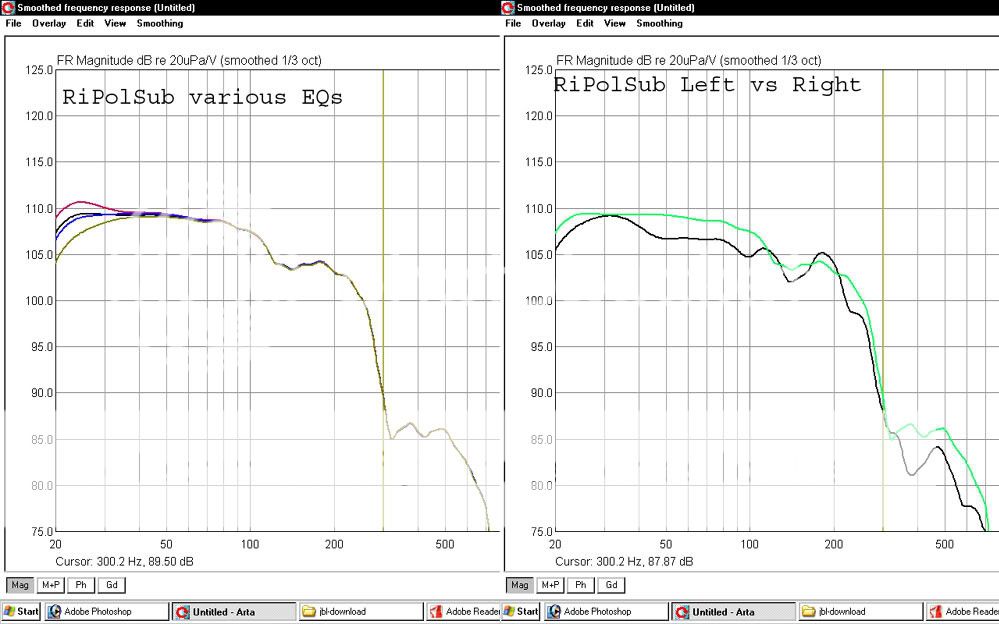
Attachments
Cowanaudio said "Interestingly a dipoles response flattens out as you get closer to the source. Many dipole bass speakers will need no eq to flatten the bottom end. "
This is the very nature of large dipoles. In the post above there is simulation at 4m and measurement indoor at roughly 1m and we have seen many measurements at the mouth. Indoor measurements are very tricky with all the modes seen with long IR gating required to see low frequencies in the first place.
These a basics that one must comprehend to be able to interprete measurements and statements. Many web pages are full of amazing results with dipole or ripole subwoofers, but I very rarely see descripitons how measurements were done, what size the room was etc. essential info.
Here is pixelpusher's simulation at 10 vs. 1m vs. 20cm distance. His first one had 100m distance (300') Edge has anechoic conditions always.
This is the very nature of large dipoles. In the post above there is simulation at 4m and measurement indoor at roughly 1m and we have seen many measurements at the mouth. Indoor measurements are very tricky with all the modes seen with long IR gating required to see low frequencies in the first place.
These a basics that one must comprehend to be able to interprete measurements and statements. Many web pages are full of amazing results with dipole or ripole subwoofers, but I very rarely see descripitons how measurements were done, what size the room was etc. essential info.
Here is pixelpusher's simulation at 10 vs. 1m vs. 20cm distance. His first one had 100m distance (300') Edge has anechoic conditions always.
Attachments
Last edited:
- Home
- Loudspeakers
- Multi-Way
- In Pursuit of a 20-20k Dipole Loudspeaker
